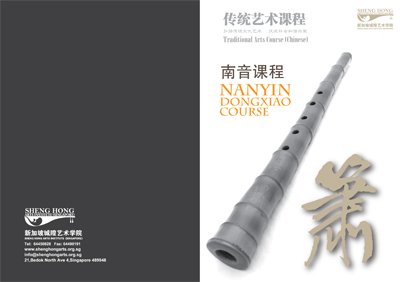don-xiao video
don-xiao video
http://www.youtube.com/watch?v=uL_KHnZcGiw&NR=1&feature=endscreen
Does anybody know what this is? Looks more like shakuhachi than the usual xiao.
Does anybody know what this is? Looks more like shakuhachi than the usual xiao.
Mmmmmm... sounds like a don xiao.... but built like the shakuhachi....
My guess - which is not very qualified - is that this is somebody who has been inspired by the looks of the shakuhachi and made a cross-over of shakuhachi looks and don xiao placement of holes etc.
My guess - which is not very qualified - is that this is somebody who has been inspired by the looks of the shakuhachi and made a cross-over of shakuhachi looks and don xiao placement of holes etc.
It's a Chinese dongxiao, aka the nanyin dongxiao, a short, thicker version of the xiao and an ancestor of the shakuhachi. The modern 6 hole version was developed during the Ming Dynasty. Here's a description of a cheap flute on Amazon: 6 Holes Shakuhachi Dong Xiao G Key w. root End Bamboo Flute Zen Instrument Kinko Voicing Hole with Bamboo Canister from High Altitude Seasoned Bamboo Forest in Central Taiwan (Nantou County). Regarded as a Zen instrument. Sounding is clear and resonate passively in the serene bamboo forest country setting. Length is : 25 & 7/8 inches. Weight : 11.7 Oz. No. of bamboo Nodes : 9
You can also hear it on a CD called "Dream of Red Mansions: Dongxiao (Flute) Music" (not available from Amazon).
You can also hear it on a CD called "Dream of Red Mansions: Dongxiao (Flute) Music" (not available from Amazon).
I agree it is a Nanyin dongxiao.
Still intrigues me the way this one looks... but why not
A pic I found online.

The nankin dongxiao is distinctive to southern Taiwan. It is played as a part of an ensemble accompanying a vocal genre, in which a singer marking the main beats with clappers is accompanied by four melodic instruments: pipa fretted plucked lute, dongxiao end-blown flute, erxian bowed lute and sanxian plucked lute. There are some suites for the instrumental ensemble alone.
Still intrigues me the way this one looks... but why not

A pic I found online.

The nankin dongxiao is distinctive to southern Taiwan. It is played as a part of an ensemble accompanying a vocal genre, in which a singer marking the main beats with clappers is accompanied by four melodic instruments: pipa fretted plucked lute, dongxiao end-blown flute, erxian bowed lute and sanxian plucked lute. There are some suites for the instrumental ensemble alone.

I've always loved the violin-type tone of the Xiao. I wonder how much the smaller holes and unique blowing end contribute to that quality?
For those that speak mandarin, he really gets into the methodology here:
http://www.youtube.com/watch?v=iNVRaiNJKyc&feature=related

For those that speak mandarin, he really gets into the methodology here:
http://www.youtube.com/watch?v=iNVRaiNJKyc&feature=related
And for those who read mandarin : http://www.donsiau.net/main_n.htm / http://www.donsiau.net/style.htm
I know about xiao. This particular one however looks and sounds a lot more like our friend the jinashi and looks longer than the usual xiao.
I think that's diaphragmatic vibrato he's using. Would it be safe to assume that's typical for this instrument and style?
"Brian Tairaku Ritchie""Brian Tairaku Ritchie"I know about xiao. This particular one however looks and sounds a lot more like our friend the jinashi and looks longer than the usual xiao.
From my small understanding of this Chinese flute, it is a Taiwanese variant of the mainland originals. Initially, during the Han Dynasty, xiao had buzzing membranes, like the side-blown dizi. During the Tang era, both the xiao and dizi emigrated to neighboring Korea, where they became well-established indigenous instruments, as the daegeum and tungso (in direct reference to Tang China). After the Tang Dynasty, Chinese xiao dropped the slot for the membrane and became more basic in design.
The typical mainland xiao is between 32"- 38" long (although I've seen longer and shorter examples). I've got 2 of the longer, thinner types and 1 dong-xiao with a descent root end, heavy walled bamboo. The embouchure is slightly different between the two variations, as is the shape of the blowing end.
As Chris clearly intimated, the root end Taiwanese dong-xiao is the ancestor of both, the Japanese shakuhachi and the Korean danso, as well. Obviously, either the Korean end-blown flutes initially created the 5-hole pentatonic scale pattern... or they were influenced by the Japanese, after passing the design along to Nippon? Does anyone here know?
We see this phenomenon with swords, though. The earliest Japanese swords were cast in bronze on the Korean peninsula. The same goes for forged steel sabers. Of course, what the Japanese did with the Chinese-inspired Korean design of these early swords has become legendary. The tachi and later on, the katana. So much so, that the design emigrated to the Korean mainland and even China. The rest is just history.
Répondre
